Selecting the appropriate footwear is paramount when preparing for a hiking adventure in the Dolomites. The terrain is diverse, ranging from rocky paths to muddy trails, and the right shoes can significantly impact your comfort and safety. Hiking boots are often recommended due to their ankle support and rugged soles, which provide traction on uneven surfaces.
A good pair of boots should be waterproof, as sudden rain showers can occur, and wet feet can lead to blisters and discomfort. Brands like Salomon, Merrell, and Lowa offer models specifically designed for alpine conditions, featuring Gore-Tex linings that keep feet dry while allowing moisture to escape. In addition to waterproofing, consider the fit and weight of the footwear.
A well-fitted boot should feel snug but not constricting, allowing for some movement of the toes while providing support to the arch and heel. Lightweight hiking shoes or trail runners can be suitable for less technical trails, offering breathability and comfort over long distances. However, for more challenging hikes that involve scrambling or rocky ascents, a sturdier boot with a stiffer sole is advisable.
It’s also wise to break in new footwear before embarking on a long hike to avoid painful blisters and ensure that your feet are accustomed to the shoes.
Key Takeaways
- Choose sturdy and supportive hiking boots with good traction for Dolomites hiking
- Layer clothing to easily adjust to changing weather conditions in the mountains
- Wear breathable and moisture-wicking clothing to stay comfortable and dry during hikes
- Pack essentials such as water, snacks, map, first aid kit, and extra layers for a day hike in the Dolomites
- Use sun protection and sunglasses to shield yourself from the strong UV rays at high altitudes
Layering for changing weather conditions
The weather in the Dolomites can be unpredictable, with conditions shifting rapidly throughout the day. Therefore, layering your clothing is essential for adapting to these changes. The three-layer system—base layer, insulation layer, and outer layer—provides flexibility and comfort.
The base layer, typically made from synthetic materials or merino wool, should wick moisture away from the skin to keep you dry. This is particularly important during strenuous hikes when perspiration can lead to chills if it’s not managed properly. The insulation layer serves to retain body heat and can be a fleece jacket or a lightweight down vest.
This layer can be easily added or removed depending on the temperature and your activity level. Finally, the outer layer should be a waterproof and windproof shell that protects against rain and wind. Look for jackets with ventilation options, such as pit zips, which allow for airflow without having to remove the jacket entirely.
This layering approach not only keeps you comfortable but also allows you to adjust your clothing as you ascend or descend in elevation, where temperatures can vary significantly.
The importance of breathable and moisture-wicking clothing

Breathable and moisture-wicking clothing is crucial for maintaining comfort during hikes in the Dolomites. Fabrics designed for outdoor activities often incorporate advanced technologies that facilitate moisture management. For instance, polyester and nylon blends are commonly used in hiking apparel because they dry quickly and allow sweat to evaporate away from the body.
This is particularly beneficial in warmer weather or during intense physical exertion when sweat production increases. Moreover, wearing breathable fabrics helps regulate body temperature, preventing overheating during climbs or strenuous sections of the trail. Merino wool is another excellent option; it not only wicks moisture but also has natural temperature-regulating properties, keeping you warm in cooler conditions while remaining cool when it’s hot outside.
When selecting hiking attire, pay attention to features such as mesh panels or ventilation openings that enhance airflow. These elements contribute significantly to overall comfort, allowing you to focus on the stunning landscapes rather than being distracted by discomfort from damp or heavy clothing.
Packing essentials for a day hike in the Dolomites
| Item | Quantity |
|---|---|
| Backpack | 1 |
| Water bottle | 1 |
| Snacks (trail mix, energy bars) | 2 servings |
| Map of the area | 1 |
| Compass | 1 |
| Sunscreen | 1 |
| Sunglasses | 1 |
| First aid kit | 1 |
| Lightweight rain jacket | 1 |
| Extra clothing layers | 1 set |
| Whistle | 1 |
| Multi-tool or knife | 1 |
When planning a day hike in the Dolomites, packing the right essentials is vital for a successful outing. A well-structured daypack should include items that cater to both your needs and potential emergencies. Start with sufficient water; hydration systems or water bottles should hold at least two liters of water per person for a full day of hiking.
Additionally, consider packing water purification tablets or a filter if you plan to refill from natural sources along the trail. Food is another critical component of your pack. High-energy snacks such as trail mix, energy bars, or jerky provide quick fuel during breaks.
For lunch, opt for lightweight options like wraps or sandwiches that are easy to carry and consume on the go. Beyond food and water, include a first-aid kit stocked with essentials like adhesive bandages, antiseptic wipes, and pain relievers. A map or GPS device is also crucial for navigation, especially in areas where trails may not be well-marked.
Lastly, don’t forget a headlamp or flashlight in case your hike extends into the evening hours.
Sun protection and sunglasses for high-altitude hiking
Hiking in the Dolomites exposes you to higher levels of UV radiation due to increased altitude and reflective surfaces like snow and rock. Therefore, sun protection is an essential consideration for any hiker venturing into these stunning mountains. Broad-spectrum sunscreen with an SPF of at least 30 should be applied generously to all exposed skin, including areas often overlooked such as the ears and back of the neck.
Reapplication every two hours is necessary, especially if you are sweating or after swimming in alpine lakes. Sunglasses are equally important for protecting your eyes from harmful UV rays and glare. Look for sunglasses that offer 100% UV protection and have polarized lenses to reduce glare from reflective surfaces.
This feature is particularly beneficial when hiking near snowfields or lakes where sunlight can bounce off the surface intensely. Additionally, consider wearing a wide-brimmed hat or a cap with a neck flap for added protection against sun exposure. These measures will help prevent sunburn and long-term skin damage while ensuring that you can fully enjoy the breathtaking views without discomfort.
Considerations for hiking in different seasons

The Dolomites offer unique hiking experiences across all seasons, each presenting its own set of challenges and considerations. In summer, trails are generally accessible, but it’s essential to be aware of potential thunderstorms that can develop in the afternoons. Early starts are advisable to avoid being caught in adverse weather conditions later in the day.
Summer also brings an abundance of wildflowers and lush greenery, making it an ideal time for those seeking vibrant landscapes. Autumn transforms the Dolomites into a canvas of rich colors as leaves change hues, providing a stunning backdrop for hikes. However, temperatures can drop significantly as winter approaches, so layering becomes even more critical during this season.
In contrast, winter hiking requires specialized gear such as snowshoes or crampons for icy trails. Avalanche awareness is crucial during this time; checking local conditions and forecasts before heading out is essential for safety. Spring offers a mix of melting snow and blooming flora but can also present muddy trails; waterproof footwear becomes particularly important during this transitional season.
Accessories to enhance your hiking experience in the Dolomites
Accessories play a significant role in enhancing your hiking experience in the Dolomites by providing convenience and comfort on the trail. Trekking poles are one such accessory that can alleviate strain on your knees during descents and provide stability on uneven terrain. They help distribute weight more evenly and can be particularly useful when navigating rocky paths or steep inclines.
Another valuable accessory is a hydration bladder or reservoir system that allows you to drink water hands-free while walking. This feature encourages regular hydration without needing to stop frequently to reach for a water bottle. Additionally, consider packing a lightweight camera or smartphone with a good camera function; capturing the breathtaking vistas of the Dolomites will create lasting memories of your adventure.
A portable power bank can ensure that your devices remain charged throughout your hike, allowing you to document your journey without worrying about battery life.
Safety gear and emergency essentials for Dolomites hiking
Safety gear is an indispensable part of any hiking kit when exploring the Dolomites’ rugged terrain. A whistle can be a lifesaver in emergencies; it’s lightweight and easy to carry but can be heard over long distances if you find yourself lost or in need of assistance. A multi-tool or knife can also prove invaluable for various tasks, from food preparation to making quick repairs on gear.
In addition to these items, carrying an emergency blanket or bivy sack can provide warmth if you become stranded overnight due to unforeseen circumstances. A small fire starter kit is another essential; being able to create warmth or cook food can make a significant difference in survival situations. It’s also wise to familiarize yourself with basic first-aid techniques before heading out; knowing how to treat common injuries like sprains or cuts can be crucial in remote areas where professional help may not be readily available.
By equipping yourself with these safety essentials, you can enjoy your hiking experience in the Dolomites with greater peace of mind.
If you are planning a hiking trip to the Dolomites, it is essential to know what to wear to ensure a comfortable and safe experience. One related article that may be helpful is a guide on the best time to travel to Hawaii, providing insights on the seasonal changes and weather conditions that can impact your hiking attire. For more information on what to wear hiking in the Dolomites, check out this article.
FAQs
What should I wear for hiking in the Dolomites?
When hiking in the Dolomites, it is important to wear comfortable and breathable clothing that is suitable for the weather conditions. This includes moisture-wicking base layers, a lightweight and waterproof jacket, hiking pants, and sturdy hiking boots.
What type of footwear is best for hiking in the Dolomites?
Sturdy and waterproof hiking boots with good ankle support are essential for hiking in the Dolomites. The terrain can be rugged and uneven, so it is important to have proper footwear to protect your feet and ankles.
What should I consider when choosing hiking socks for the Dolomites?
When choosing hiking socks for the Dolomites, it is important to select moisture-wicking and breathable socks that provide cushioning and support. Merino wool or synthetic blend socks are popular choices for hiking in the Dolomites.
Are there any specific clothing items I should bring for hiking in the Dolomites?
In addition to the basics, it is important to bring a hat, sunglasses, and sunscreen to protect yourself from the sun. It is also a good idea to bring a lightweight and breathable long-sleeve shirt for sun protection and to layer in case of changing weather conditions.
What should I consider when choosing a backpack for hiking in the Dolomites?
When choosing a backpack for hiking in the Dolomites, it is important to select a comfortable and durable pack with enough capacity to carry water, snacks, extra layers, a first aid kit, and any other essentials for a day of hiking. Look for a pack with adjustable straps and good back support.
